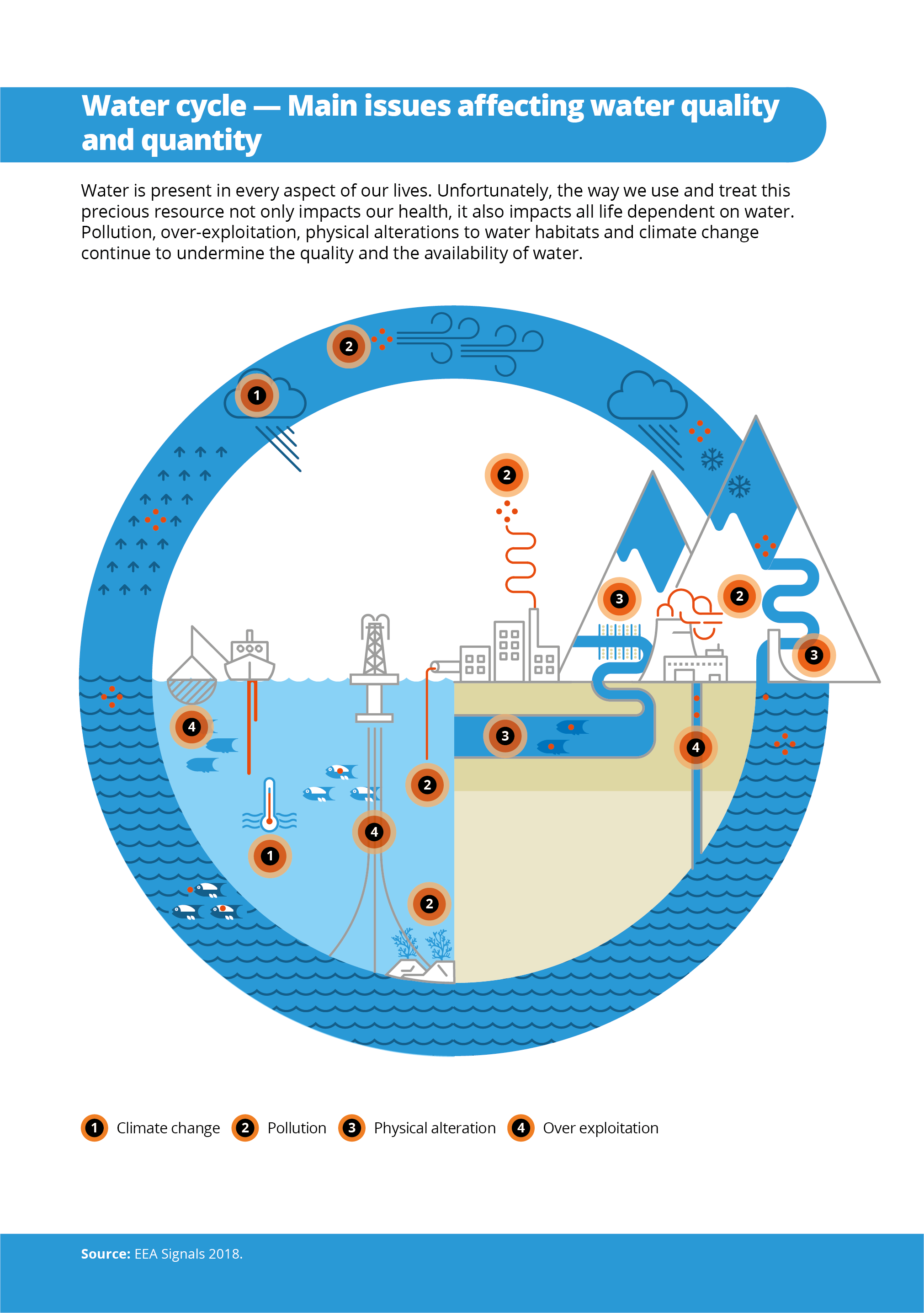Water is home to millions of species, ranging from the tiniest organisms measured in microns to blue whales up to 30 metres long and weighing up to 200 tonnes. Every year new species are discovered in the depths of the oceans. The oceans and seas also play a key role in the global climate: they are the largest carbon sink and capture carbon dioxide from the atmosphere. Ocean currents help warm and cool different regions, making them more inhabitable. Evaporation from warm seas can fall as rain or snow across the globe, sustaining life on land.
For us humans, water is not simply a vital need for our bodies, it is also a resource we benefit from every day. At home, we use it for cooking, cleaning, showering and flushing. Our food, clothes, mobile phones, cars and books all use water in their production. We use water to build our homes, schools and roads, and to heat buildings and cool power plants. With the electricity we generate from its movement, we light our cities and our homes. On a hot summer day, we dive into the sea or go for a stroll by a lake to cool off.
Water is also a means to connect and move people and goods. It offers a natural transport network around the globe, connecting not only coastal cities but also inland cities along navigable rivers, enabling global trade. Our T-shirts, coffee beans or laptops produced in the Americas, Africa or Asia might be transported to Europe by ships. In other words, water is present in every aspect of our lives.
Unfortunately, the way we use and treat this precious resource not only impacts our health, it also impacts all life dependent on water. Pollution, over-exploitation, physical alterations to water habitats and climate change continue to undermine the quality and the availability of water.
We change the nature of water
When we take water from its source and use it, we almost always alter various aspects of it. We straighten rivers, build canals to connect seas and rivers, and construct dams and levees to cater for our water use. Groundwater extracted from aquifers could be transported hundreds of kilometres to be delivered to our homes. Once used, it can be contaminated by chemical substances (e.g. phosphates used in cleaning products), plastic microbeads or cooking oil. Some of these pollutants and impurities can remain in the water even after undergoing advanced waste water treatment processes. In the case of agriculture, water used for crops can contain residues of chemicals used in fertilisers and pesticides. After being used and sometimes treated, some of this altered water returns to a water body.
Even air-borne pollutants released by transport and industry can be deposited on rivers, lakes and seas and can impact water quality. Our water use can alter the temperature and salinity levels of oceans. The water used for cooling in the energy sector can be significantly warmer than the water abstracted. Similarly, desalination processes can release brine with high salt concentrations back to the marine environment. In the end, what we return to nature is often very different from what we extracted. Moreover, we do not always return it to where we extracted it.
Water quality matters
In the last four decades, Europe has made significant progress in regulating its water quality, treating its waste water and protecting its marine and freshwater habitats and species. EU policies address a wide range of issues from drinking water, urban waste water, protection of habitats, designating marine protected areas and bathing water quality to floods, single use plastics, industrial emissions and restrictions on the use of hazardous chemicals. These specific pieces of EU legislation are strengthened by overarching programmes and legislation, such as the Seventh Environment Action Programme, the Water Framework Directive and the Marine Strategy Framework Directive.
And Europeans care about the quality of their water. It is no coincidence that the first ever EU citizens’ initiative, namely Right2water, which was supported by more than 1.8 million signatories, was on water. Awareness-raising schemes combined with water-efficient technologies and investments in leakage management have resulted in real water savings across Europe. The total amount of water abstracted in Europe has decreased by 19 % since 1990. Today more than 80 % of the European population is connected to an urban waste water treatment plant, which significantly reduces the amount of pollutants entering water bodies. Our recent report on the state of water shows that about three quarters of Europe’s groundwater bodies have good chemical status: they are clean.
Regular monitoring of bathing water quality showed that about 85 % of the EU’s bathing sites monitored in 2017 were ‘excellent’. More than 10 % of Europe’s seas have been designated as marine protected areas to help preserve marine species and habitats. These are all very encouraging improvements. Yet, despite the progress, the ecological and chemical statuses of Europe’s surface waters continue to cause concern.
Of surface waters, only about 39 % achieved the EU target of minimum ‘good’ or ‘high’ ecological status during the 2010-2015 monitoring period, while 38 % achieved ‘good’ chemical status. Poor chemical status arises partly because pollutants (e.g. nitrates from agriculture) do not just disappear. Water absorbs and moves pollutants around and they end up accumulating in lakes and oceans. Many rivers have been physically altered or impacted by human activities, affecting fish migration upstream or sediment flow downstream.
Many marine fish stocks are over-exploited, threatening the survival of entire fish populations. Invasive alien species spread by ship transport or through canals, endangering local species. Marine litter, dominated by plastics, is found in all corners of the world from the Arctic to uninhabited islands in the Pacific. And ,unfortunately, even if we stop new pollutants from entering water bodies, we face the legacy of all the pollutants released to water decades or, as in the case of mercury, centuries ago. And future generations will face the legacy of our releases.
Coping with scarcity and excess
Compared with many parts of the world, Europe has relatively abundant freshwater resources. However, these resources are not evenly distributed across the continent. In fact, according to our estimates about one third of the EU territory is exposed to water stress in which the demand exceeds the available supply for a certain period.
Climate change is projected to impact the availability of water in Europe, putting additional pressure on southern regions already facing water stress. Other parts of Europe are expected to face more frequent flooding events, while low-lying regions are at risk from storm surges and sea level rise. Cities and regions are at the forefront of actions on the ground and are implementing measures ranging from leakage reduction and water reuse to incorporating blue and green areas in urban areas to minimise flooding risks and water damage.
Some key economic sectors, such as agriculture, use significant amounts of freshwater. In fact, during the spring and summer months, agricultural activities might be responsible for more than half of the water use in parts of southern Europe. Similarly, popular tourist destinations, including small islands in the Mediterranean, might need to provide water for thousands of visitors, putting considerable pressure on their already scarce water supplies.
A local and global resource
Mass tourism is not the only time local water resources come under extra pressure because of non-local users. Global trade enables consumers to use the natural resources, including water, from all parts of the world. French wine exported to China also ‘exports’ the water used in growing the vines and making the wine. Likewise, goods imported into Europe also import ‘virtual water’.
In many ways, water is a local resource. Changes to water quantity or quality have direct impacts on the local environment and local population. But water as a whole is also a global body — a common good shared by everyone and all living things on our planet. Water moves across countries and connects continents physically and culturally. Because many large water bodies are connected, what can start as a local problem can become one of many contributors to a larger problem. Conversely, a global problem, such as plastics or higher water temperatures in the oceans, can have more severe impacts locally.
This local-to-global nature of water demands cooperation and governance structures that match the scale of the challenge at issue. It is not surprising that many EU policies on freshwater and the marine environment emphasise regional and global cooperation. The EU is an active player in governance structures ranging from the United Nations’ Sustainable Development Goals to regional cooperation structures, such as the International Commission for the Protection of the Danube River or the OSPAR Commission for the North-East Atlantic. In recent years, governance structures have rightly involved non-state actors, such as large fishing companies, to ensure sustainable use of water resources.
Faced with growing demands from competing users, it is clear that the path to sustainable use of water and its resources goes through efficiency, innovation, preventing waste (e.g. reducing leakage), reusing, recycling — all key components of a circular economy. In fact, when we save one resource, such as water, we save on all others.
Knowledge to help shape future policies
The European Environment Agency works with environmental information. A complex and inter-connected topic such as water requires different data streams, in-depth and systemic analysis, and close collaboration with networks and institutions. The EEA brings together all this knowledge on Europe’s environment and informs policymakers and the public.
Over the last four decades, in line with EU legislation and reporting requirements, Member States have put in place extensive monitoring structures. Thanks to these efforts, our knowledge and understanding of the issues and trends relating to the environment, including water, are much more detailed and comprehensive. We can now have an integrated analysis of what drives change, what is changing and how. We can identify effective measures on the ground and build networks to share this information.
This knowledge will be instrumental in shaping future EU policies on water. Some key components of water legislation, including the Water Framework Directive and Urban Waste Water Treatment Directive, are being evaluated and might be subsequently amended. Given the vital role of water in all aspects of our lives, a more integrated policy approach will help us protect and preserve what makes our planet unique: water.

Hans Bruyninckx
EEA Executive Director


Document Actions
Share with others